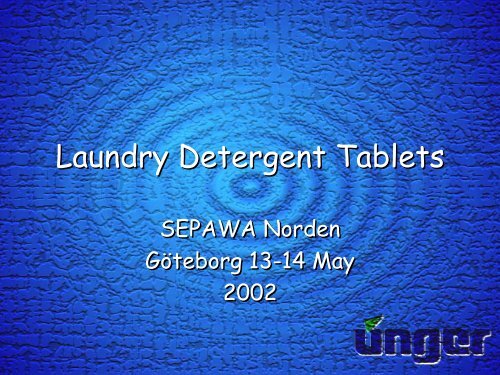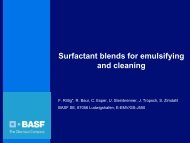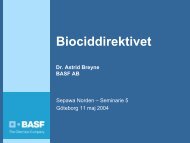Laundry Detergent Tablets - Sepawa
Laundry Detergent Tablets - Sepawa
Laundry Detergent Tablets - Sepawa
You also want an ePaper? Increase the reach of your titles
YUMPU automatically turns print PDFs into web optimized ePapers that Google loves.
<strong>Laundry</strong> <strong>Detergent</strong> <strong>Tablets</strong><br />
SEPAWA Norden<br />
Göteborg 13-14 May<br />
2002
Patent Search
35<br />
30<br />
25<br />
20<br />
15<br />
10<br />
5<br />
0<br />
Field Patents<br />
Nr. of Patents<br />
1976-1980 1981-1985 1986-1990 1991-1995 1996-2002
History<br />
• 60’s <strong>Tablets</strong> introduced in the north<br />
American market – discontinued in<br />
1978. (Savo by P&G)<br />
• Re-launched in Europe by Unilever in<br />
1998<br />
• Been sold in Spain since the mid-80’s
” What's not likely to catch on with U.S.<br />
consumers, though, is washing tablets. While<br />
their popularity is growing in Europe, no major<br />
marketer here plans to roll them out,<br />
especially considering that previous attempts<br />
have failed miserably, several marketers said.<br />
Furthermore, tablets require that they be<br />
placed in a bag. Other product forms include<br />
washing gel, introduced in Europe, but there is<br />
little discussions about a possible U.S.<br />
introduction.”<br />
Happi magazine cover story January 2000
History<br />
• September 2000 P&G introduced Tided<br />
<strong>Tablets</strong><br />
• January 2001 Lever launched Wisk <strong>Tablets</strong><br />
• March 2001 Purex tablets by Dial Corp.<br />
• By summer 2001 tablets reportedly<br />
achieved nearly 10% market share in the<br />
U.S - REVOLUTION
90<br />
80<br />
70<br />
60<br />
50<br />
40<br />
30<br />
20<br />
10<br />
0<br />
Market Trends<br />
Eropean laundry market (%)<br />
1998 2000 2001<br />
Powder<br />
Liquid<br />
Other
Compaction and Dissolution<br />
Strong enough to withstand handling and<br />
transport<br />
Vs.<br />
Should be readily dissolved and<br />
dispersed
•Use of a binder<br />
Remedy<br />
• Coating the tablet<br />
• Use of disintegrants<br />
• Avoiding gel formation
Binder<br />
• Helps holding the tablet together -<br />
lower compact pressure<br />
Example: PEG1500
Coating<br />
• Increased surface hardness<br />
•Improved aesthetics<br />
• Applied as melt or solution<br />
• Improved hydrophobicity<br />
• Should include a disintegrant
• Four classes<br />
Disintegrants<br />
– (i) cause disintegration by evolving gas, such as sodium<br />
bicarbonate in the presence of citric acid or tartaric acid<br />
– (ii) those which promote water absorption, such as<br />
starch, colloidal silicon dioxide, carbocymethyl cellulose<br />
and rice starch<br />
– (iii) those which swell, for example crossed linked<br />
polyacrylic acids, cross linked gum arabic, carboxymethyl<br />
cellulose<br />
– (iv) those which increase porosity such as potato and<br />
corn starch, an finally those which undergo<br />
physiochemical bonding such as cellulose and kaolin.
Disintegrants<br />
Used in combination<br />
– Same class: swellable cellulose and<br />
polyacrylic acids<br />
– Different classes: swellable polyacrylic<br />
acid with water transporting colloidal<br />
silica.
Disintegrants<br />
Highly water soluble salts<br />
Material Water solubility<br />
(g/l)<br />
Sodium citrate dihydrat 720<br />
Potassium carbonate 1120<br />
Urea >1000<br />
Sodium acetat, anhydrous 1190<br />
Sodium acetat, trihydrat 760<br />
Magnesium sulphate, heptahydrat 710<br />
Potassium acetat >2000
Avoiding Gel Formation<br />
• Acute when using spray-dried<br />
powders, surfactant evenly<br />
distributed in tablet.<br />
• Better to keep the anionic surfactant<br />
in discrete regions.
Tower vs. Non-tower<br />
• Tower process<br />
powders<br />
– Involves drying<br />
– Homogeneous product – no segregation<br />
problems<br />
• Non-tower process<br />
– Dry blend, post addition, no drying<br />
– Heterogeneous product – segregation<br />
problems
<strong>Tablets</strong><br />
• Compressed in to a single element –<br />
segregation can not occur.<br />
• Preferably produced by dry blending<br />
• No drying necessary – cost efficient
The Future<br />
• <strong>Tablets</strong> have settled at 10-15% market<br />
share<br />
• Market characterized by ever-new<br />
products<br />
• <strong>Tablets</strong> give formulation freedom<br />
• Platform for new products





